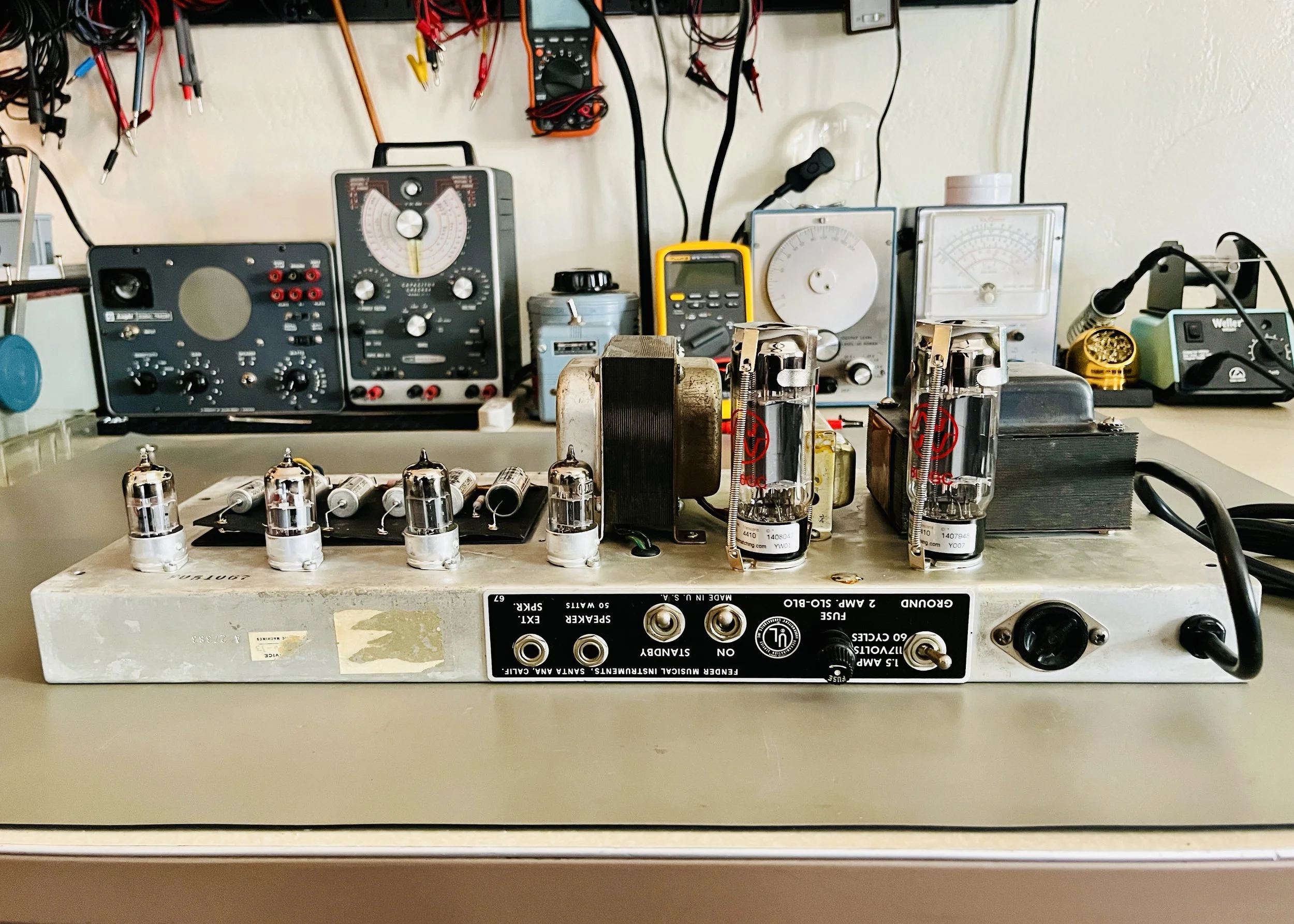1967 Fender Bassman
The Black-Panel era Bassman came in a few variants: the 6G6B “tuxedo model” (which was just the earlier Blonde Bassman with Black-Panel cosmetics), the AA864, AA165, and AB165 models. This is the AB165 circuit which has a number of unique features that make it quite different from it’s predecessor - the AA864. The AB165 Normal Channel has an added 3rd gain stage before the phase inverter, and it makes use of a number of negative feedback loops throughout the power-amp and preamp. More gain stages means more distortion/overdrive, and more negative feedback (especially the loops from the 6L6GC plates to the PI plates, and the local loop around the 3rd driver stage) means better linearity and less noise. Many people like to convert the AB165 back to AA864 specs because they are more valuable, and because the myth developed that the AA864 sounds much better. I will say that they certainly sound different but not better in my opinion. The earlier AA864 is cleaner and sounds more Black-Panel Fender-like, while this particular amp that we have here has more mid-range, grind, and growl then any other Black-Panel or Silver-Panel Fender. So if you like overdrive but still want a classic 60’s era Fender build this is the amp for you. This amp is very popular with punk and rockabilly artists and was also used by Tom Petty, Mike Campbell, Mike Bloomfield, and John Fogerty.
This amp came in mostly original condition with the exception of someone having changed the power tubes (and associated screen resistors) to 6550’s instead of the correct 6L6GC’s. 6550’s draw nearly twice the heater current of 6L6GC’s and this amps Power Transformer is not rated to supply that amount of current. Over time this would destroy the valuable PT. The amp was also blowing fuses and would not power up. With the original 60 year old filter caps and the wrong power tubes it was no wonder why.
All caps were replaced with upgraded voltage and temperature rated MOD brand electrolytic’s. New 2 Watt Metal Oxide/5 Watt Cement power dropping resistors were installed for better reliability and lower noise floor. New 3 Watt Cement Screen Grid resistors were installed for reliability reasons. New vintage spec correct Carbon Comp 1/2 Watt resistors were installed for the plates and cathodes of all preamp circuits (and a few odd locations) to fix the issues with value drift and noise. This also means that we retain collector’s grade build quality/value of the amp.
The Bias Supply was given my standard modification to be an Adjustable Fixed Bias control rather then the original Balance control - this allows the power tubes to be set to idle at the correct current/voltage. The Balance control only allows adjustment of how even the bias is between each pair of 6L6GC’s, it provides no way to adjust how hot or cold the bias is to the power tubes. This obviously is not a great design choice and is something I change right away anytime I see it present.
Two of the original tubes tested good and the others were replaced: V1 = JJ 12AX7MG, V2 = JJ 12AX7S, V3 = RCA 12AX7 V4 = RCA12AT7, V5-V6 = JJ 6L6GC Matched Pair. These tubes were picked for best tone, and reliability. The 6L6GC's Fixed Bias was set to %62 Class AB Plate Dissipation with a B+ of 436VDC. All tube sockets were cleaned with De-Oxit and re-tensioned with the power tube sockets getting all new spring style tube retainers - this solved the loose tube issue and noise caused by dirty connections. The pots were sprayed out with De-Oxit and the amp was cleaned inside and out. A new 3 prong AC cord was installed to replace the un-safe original and the death cap was deleted rendering the ground switch deactivated. Amp now sounds great.












